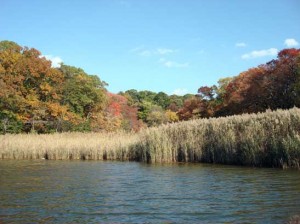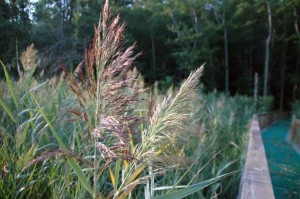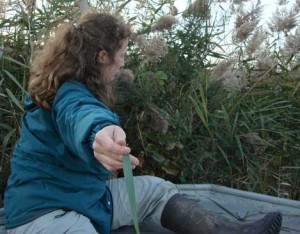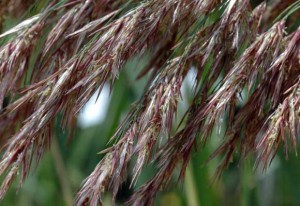
The non-native strain of Phragmites australis dominates many Chesapeake Bay wetlands. Photo Melissa McCormick.
The sudden spread of the invasive P. australis fascinated SERC’s Melissa McCormick, Dennis Whigham and Karin Kettenring. The rapid expansion around the Chesapeake Bay began in the 1980s and highlights a key frustration for scientists and resource managers: it’s difficult to predict which non-native species will thrive in a new environment and which ones will fail.

Two different genotypes of a non-native strain of Phragmites australis growing in a SERC wetland. Smithsonian scientists have discovered that genetic diversity within patches of P. australis produce more viable seeds, further fueling the expansion of the invasive plant. Photo Melissa McCormick.
P. australis finagles its way into coastal wetlands when the soil is exposed. This can happen when a muskrat munches away at vegetation or a homeowner builds a seawall or other shoreline-hardening structure. Until now, scientists did not understand how P. australis was making these exposed areas home. P. australis can reproduce sexually through seeds or clonally, through rhizomes — thick underground stems that sprout new plantlets.
In fall 2007 the three SERC ecologists set out to determine which reproduction method was responsible for P. australis’ successful spread. They hopped into a small jon boat, and braved shipping traffic and bad weather to collect leaf samples in nine subestuaries within the Chesapeake Bay.

Smithsonian plant ecologist Melissa McCormick hands her colleague a Phragmites australis leaf sample. Photo Karin Kettenring.
In the end they gathered around 1,500 samples that they ran DNA analysis on. “I’ve always been interested in what patterns of genetic diversity can tell us about how plants got to their habitats,” explains McCormick. If the plants propagated through rhizomes, the P. australis patches would be genetically very similar because each offspring is simply a clone of the parent. However, the genetic variation would be greater if P. australis was reproducing sexually through seeds.
McCormick found that of the 167 P. australis patches they surveyed, 92% were composed of multiple genetic individuals and that no genetic signature was repeated among the patches. This was a clear signal that seeds have driven P. australis’ explosive expansion in the Chesapeake Bay’s brackish wetlands. Furthermore, in a separate study Whigham and Kettenring found that P. australis patches with greater genetic diversity produced more viable seeds. “It’s a red flag,” says Whigham, “the research demonstrates that P. australis has the potential to continue to expand at an ever-increasing rate.”

Smithsonian scientists discovered that seeds - not underground rhizomes - are driving the expansion of the non-native Phragmites australis around the Chesapeake Bay. Photo Melissa McCormick.
Whigham, Kettenring and McCormick are busy sharing their findings with regional resource managers. Their advice: work on a large geographic scale and focus on the genetically-rich patches that crank out seeds. The trio hopes their research will inform a new strategy for dealing with P. australis in the Chesapeake Bay, one that will give native marsh plants room to grow.
These new findings have been published in the March issue of the journal Wetlands. Subscribers to the journal can access the paper here.


If the plants propagated through rhizomes, the P. australis patches would be genetically very similar because each offspring is simply a clone of the parent. However, the genetic variation would be greater if P. australis was reproducing sexually through seeds.
Amazing how such a basic plant can do this.
The success of invasive reeds likely comes down to one thing: flexibility. They are better able to adapt to change.